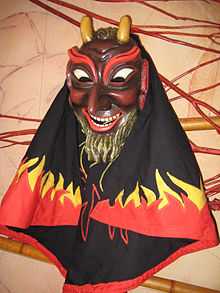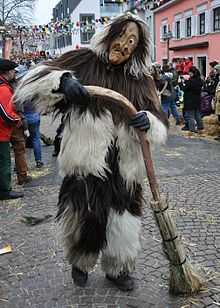Swabian-Alemannic Fastnacht

The Swabian-Alemannic Fastnacht, Fasnacht (in Switzerland) or Fasnat/Faschnat (in Vorarlberg), is the pre-Lenten carnival in Alemannic folklore in Switzerland, southern Germany, Alsace and Vorarlberg.
Etymology
Popular etymology often links Fastnacht (in Mainz also Fassenacht, in Switzerland Fasnacht, in Swabia Fasnet, Fasent) with fasten ("to fast") – allegedly from celebrations on the eve preceding fasting. Comparison of dialect variants however yields an OHG *fasanaht, with an element fasa- of unclear meaning. A likely derivation looks to PIE pwo- "purify" (cognate to pava-mana), or alternatively to Middle High German vaselen "prosper, bud", and interprets the festival as a fertility rite.
Fasching (MHG vaschanc or vaschang) is related, probably originally with a second element -gang instead of -nacht.
Overview

Fastnacht is held in the settlement area of the Germanic tribes of the Swabians and Alemanns, where Swabian-Alemannic dialects are spoken. The region covers German Switzerland, the larger part of Baden-Württemberg, Alsace, south-western Bavaria and Vorarlberg (western Austria).
The festival starts on the Thursday before Ash Wednesday, known as Schmotziger Donnerstag. In Standard German, schmutzig means "dirty", but in the Alemannic dialects schmotzig means "lard" (Schmalz), or "fat";[1] "Greasy Thursday", as remaining winter stores of lard and butter used to be consumed at that time, before the fasting began. Elsewhere the day is called "Women's Carnival" (Weiberfastnacht), being the day when tradition says that women take control. In particular regions of Tyrol, Salzburg and Bavaria traditional processions of the Perchten welcome the springtime. The Schönperchten (beautiful Perchts) represent the birth of new life in the awakening nature, the Schiachperchten ("ugly Perchts") represent the dark spirits of wintertime.[2] Farmers yearn for warmer weather and the Perchtenlauf (Run of Perchts) is a magical expression of that desire. The nights between winter and spring, when evil ghosts are supposed to go around, are also called Rauhnächte (rough nights).
Switzerland

- Basel (Basler Fasnacht): Schnitzelbangg
In protestant Basel, Fasnacht astonishingly begins on the Monday after Ash Wednesday, since it has been existing since its many re-inventions before and after the Reformation, in its current form since about 1835.[3] Since then, it is considered to be a civil Fasnacht, quite contrary to the other large Fasnacht events in the Catholic cantons of Switzerland, mainly the one in Lucerne. The Basler Fasnacht starts with the Morgestraich when, at 4am, all the lights go out in the city and carnival participants walk through the streets with beautifully painted lanterns, costumes and typically big-nosed masks, accompanied by drummers and pipers playing piccolos. The festival continues for three days with events for children and displays of floats.
- Bernese Fassnacht
- Liestal (Chienbäse)
- Lucerne (Lozärner Fasnacht)

The Lucerner Fasnacht, based on religious, Catholic backgrounds, starts every year on the Thursday before Aschermittwoch (Ash Wednesday) with a big bang at 5am called Morgenwacht (Morning Watch). There are big parades in the afternoon on Schmotzige Donnerstag (literally: Lardy Thursday)[1] and the following Monday, called Güdismontag (literally: Paunch Monday), which attract tens of thousands of people. Lucerne's Carnival ends with a crowning finish on Güdisdienstag (literally: Paunch Tuesday) evening with a tremendous parade of big bands, lights and lanterns with even a larger audience. Quite contrary to the Basler Fasnacht, a large part of the audience are also dressed up in costumes, especially in the evenings.
See also
- Carnival of Basel
- Carnaval (in the Netherlands)
- Der Überlinger Hänsele
- Guggenmusik
- Pre-Christian Alpine traditions
References
- ↑ 1.0 1.1 "Woher hat der Schmutzige Donnerstag seinen Namen?". Regionalzeitung Rontaler AG (in German). 17 February 2013. Retrieved 2015-02-07.
- ↑ Mask of an "ugly Percht"
- ↑ "Geschichte der Basler Fasnacht" (in German). Altbasel.ch. 24 January 2009. Retrieved 2015-02-07.
Pierre Farine sieht ihre Geburtsstunde mit dem Beginn der fasnächtlichen Berichterstattung durch die Presse 1835
External links
| Wikimedia Commons has media related to Konstanz. |
| Wikimedia Commons has media related to Suabian-Alamannic Fastnacht. |
- Basler Fasnacht The official site of Fasnacht in Basel
- Fasnachts Comité The Basel Fasnachts Committee
- Konstanzer Fasnacht Pictures of the Swabian–Alemannic Carnival in and nearby Constance
- Lucerne Carnival Lucerne Carnival overview about events in the city and region
- Luzerner-Fasnacht The official website of the Lucerner Fasnacht
- Typical pictures of the Alemannic folklore Fasnacht
- Oltner Fasnacht The official site of Fasnacht in Olten
- Winterthur Fasnacht The official site of Fasnacht in Winterthur
- Weil der Stadt Fasnet The official site of Fasnet in Weil der Stadt